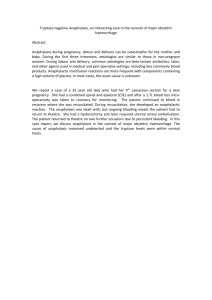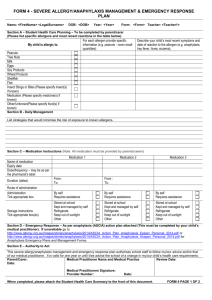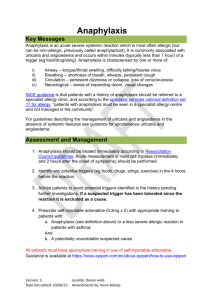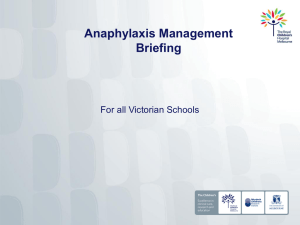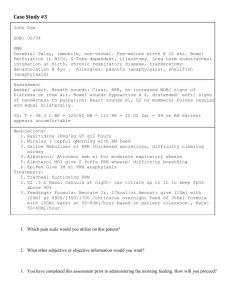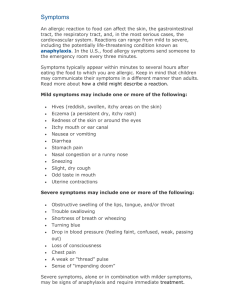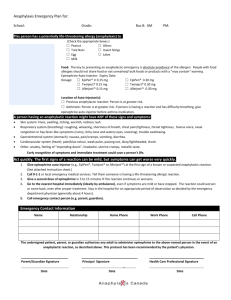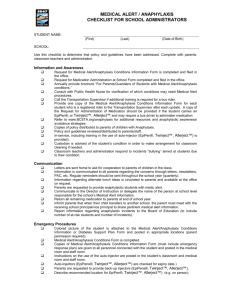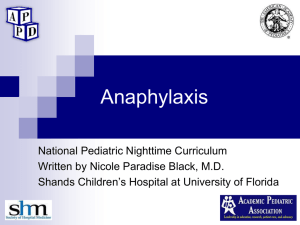Anaphylaxis Policy
advertisement
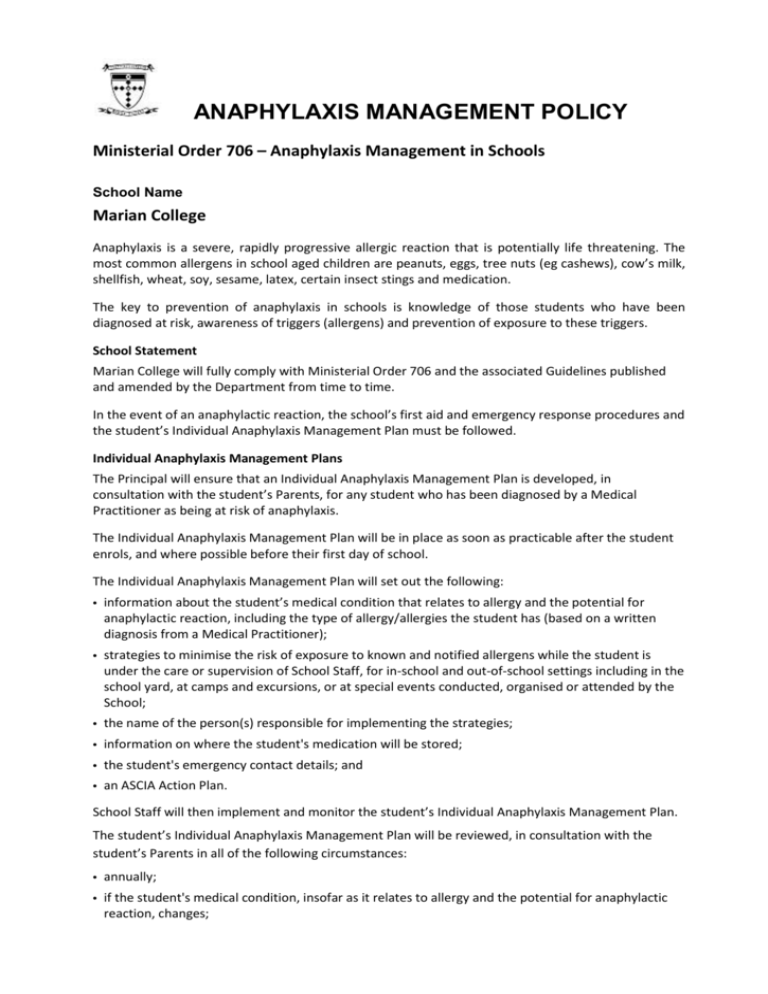
ANAPHYLAXIS MANAGEMENT POLICY Ministerial Order 706 – Anaphylaxis Management in Schools School Name Marian College Anaphylaxis is a severe, rapidly progressive allergic reaction that is potentially life threatening. The most common allergens in school aged children are peanuts, eggs, tree nuts (eg cashews), cow’s milk, shellfish, wheat, soy, sesame, latex, certain insect stings and medication. The key to prevention of anaphylaxis in schools is knowledge of those students who have been diagnosed at risk, awareness of triggers (allergens) and prevention of exposure to these triggers. School Statement Marian College will fully comply with Ministerial Order 706 and the associated Guidelines published and amended by the Department from time to time. In the event of an anaphylactic reaction, the school’s first aid and emergency response procedures and the student’s Individual Anaphylaxis Management Plan must be followed. Individual Anaphylaxis Management Plans The Principal will ensure that an Individual Anaphylaxis Management Plan is developed, in consultation with the student’s Parents, for any student who has been diagnosed by a Medical Practitioner as being at risk of anaphylaxis. The Individual Anaphylaxis Management Plan will be in place as soon as practicable after the student enrols, and where possible before their first day of school. The Individual Anaphylaxis Management Plan will set out the following: information about the student’s medical condition that relates to allergy and the potential for anaphylactic reaction, including the type of allergy/allergies the student has (based on a written diagnosis from a Medical Practitioner); strategies to minimise the risk of exposure to known and notified allergens while the student is under the care or supervision of School Staff, for in-school and out-of-school settings including in the school yard, at camps and excursions, or at special events conducted, organised or attended by the School; the name of the person(s) responsible for implementing the strategies; information on where the student's medication will be stored; the student's emergency contact details; and an ASCIA Action Plan. School Staff will then implement and monitor the student’s Individual Anaphylaxis Management Plan. The student’s Individual Anaphylaxis Management Plan will be reviewed, in consultation with the student’s Parents in all of the following circumstances: annually; if the student's medical condition, insofar as it relates to allergy and the potential for anaphylactic reaction, changes; as soon as practicable after the student has an anaphylactic reaction at School; and when the student is to participate in an overnight activity, such as camps and excursions. It is the responsibility of the Parents to: provide the ASCIA Action Plan; inform the School in writing if their child’s medical condition, insofar as it relates to allergy and the potential for anaphylactic reaction, changes and if relevant, provide an updated ASCIA Action Plan; provide an up to date photo for the ASCIA Action Plan when that Plan is provided to the School and when it is reviewed; and provide the School with an Adrenaline Autoinjector that is current and not expired for their child. Prevention Strategies Marian College will put in place Risk Minimisation and Prevention Strategies for all relevant in-school and out-of-school settings which include (but are not limited to) the following: during classroom activities (including class rotations, specialist and elective classes) in canteens during recess and lunchtimes before and after school special events including incursions, sports, cultural days, fetes or class parties, excursions and camps. School Management and Emergency Response The following procedures for emergency response to anaphylactic reactions include the following: a complete and up to date list of students identified as having a medical condition that relates to allergy and the potential for anaphylactic reaction; details of Individual Anaphylaxis Management Plans and ASCIA Action Plans and where these can be located whilst: o in a classroom; o in the canteen o in the school yard; o in all school buildings and sites including gymnasiums and halls; o on school excursions; o on school camps; and o at special events conducted, organised or attended by the school. Information about the storage and accessibility of Adrenaline Autoinjectors; how communication with School Staff, students and Parents is to occur in in accordance with a communications plan. Adrenaline Autoinjectors for General Use The Principal will oversee the purchase of Adrenaline Autoinjector(s) for General Use (purchased by the School) and as a back up to those supplied by Parents. The Principal will determine the number of additional Adrenaline Autoinjector(s) required. In doing so, will take into account the following relevant considerations: the number of students enrolled at the School who have been diagnosed as being at risk of anaphylaxis; the accessibility of Adrenaline Autoinjectors that have been provided by Parents of students who have been diagnosed as being at risk of anaphylaxis; the availability and sufficient supply of Adrenaline Autoinjectors for General Use in specified locations at the School, including Reception, West Wing Staff Study, Portables, Canteen Foyer. in the school yard, and at excursions, camps and special events conducted or organised by the School; and the adrenaline autoinjectors for General Use have a limited life, usually expiring within 12-18 months, and will need to be replaced at the School’s expense, either at the time of use or expiry, whichever is first. Communication Plan The Principal is responsible for ensuring that a communication plan is developed to provide information to all school staff, students and parents about anaphylaxis and the school’s anaphylaxis policy; The school Communication Plan includes strategies for advising School Staff, students and Parents about how to respond to an anaphylactic reaction by a student in various environments including: during normal school activities including in the classroom, in the school yard, in all school buildings and sites including gymnasiums and halls; and during off-site or out of school activities, including on excursions, school camps and at special events conducted or organised by the School. The Communication Plan includes procedures to inform volunteers and casual relief staff of students with a medical condition that relates to allergy and the potential for anaphylactic reaction and their role in responding to an anaphylactic reaction by a student in their care. The Head of Wellbeing will ensure that relevant School Staff are: trained; and briefed at least twice per calendar year. Staff Training The following School Staff will be appropriately trained: - School Staff who conduct classes that students with a medical condition that relates to allergy and the potential for anaphylactic reaction; and Any further School Staff that are determined by the Principal. The identified School Staff will undertake the following training: - an Anaphylaxis Management Training Course (valid for three years); and participate in a briefing, to occur twice per calendar year (with the first briefing to be held at the beginning of the school year) on: o the School’s Anaphylaxis Management Policy; o the causes, symptoms and treatment of anaphylaxis; o the identities of the students with a medical condition that relates to an allergy and the potential for anaphylactic reaction, and where their medication is located; o how to use an Adrenaline Autoinjector, including hands on practise with a trainer Adrenaline Autoinjector device; o the School’s general first aid and emergency response procedures; and o the location of, and access to, Adrenaline Autoinjector that have been provided by Parents or purchased by the School for general use. The briefing must be conducted by a member of School Staff who has successfully completed an Anaphylaxis Management Training Course in the last 12 months. In the event that the relevant training and briefing has not occurred, the Head of Wellbeing will develop an interim Individual Anaphylaxis Management Plan in consultation with the Parents of any affected student with a medical condition that relates to allergy and the potential for anaphylactic reaction.Training will be provided to relevant School Staff as soon as practicable after the student enrols, and preferably before the student’s first day at School. The Head of Wellbeing will ensure that while the student is under the care or supervision of the School, including excursions, yard duty, camps and special event days, there is a sufficient number of School Staff present who have successfully completed an Anaphylaxis Management Training Course in the three years prior. Annual Risk Management Checklist The Head of Wellbeing will complete an annual Risk Management Checklist as published by the Department of Education and Early Childhood Development to monitor compliance with their obligations. To be reviewed February 2015 COMMUNCATION PLAN This plan should be read in conjunction with the School’s Anaphylaxis Management Policy. It relates to the prevention and management of anaphylactic events at School or outside School on School related activities. At the time of enrolment or (if later) diagnosis, the Head of Wellbeing and First Aid Officer will familiarize themselves with the medical needs of a student with anaphylaxis. It is expected that parents will advise the school without delay when a student is diagnosed by a medical practitioner as being at risk of anaphylaxis. An Anaphylaxis Communication Plan will be developed and placed in agreed locations around the School. Marian College’s Anaphylaxis Policy and Communication Plan will be published on the School’s website and intranet site. Individual Anaphylaxis Management Plans The individual anaphylaxis management plan will be in place as soon as practicable after the student enrols and where possible before their first day of school. This should include: Information about the diagnosis, including the type of allergy or allergies the student has (based on a diagnosis from a medical practitioner). Strategies to minimise the risk of exposure to allergens while the student is under the care or supervision of school staff, for in-school and out-of-school settings including camps and excursions. The name of the person/s responsible for implementing the strategies. The student’s emergency contact details. Information on where the student’s medication will be stored. Location of EpiPens® and Student Photo’s A current up to date photo and Individual Management Plan, generic EpiPen and EpiPen provided by the parent will be located in the following locations: Location Generic Epipen Location Personal Epipen and Student Individual Management Plan Location Convent Building (downstairs) Reception Reception Convent Building (upstairs) Reception Reception Main Corridor Classrooms Reception Reception Ursula Hayes Wing Reception Reception Brendan Davey Wing West Wing Staff Study Reception Kate Griffin Wing West Wing Staff Study Reception Art Room West Wing Staff Study Reception Technology Room West Wing Staff Study Reception Portables Portables Office Reception Music Rooms Portables Office Reception St Mary’s Hall Portables Office Reception Canteen Cupboard Canteen Foyer (U11 key) Reception Gymnasium Cupboard Canteen Foyer (U11 key) Reception Applied Learning Centre Cupboard Canteen Foyer (U11 key) Reception Casual Relief Teachers/ Volunteers Anaphylaxis information will be provided to all Relieving/Volunteer staff regarding students and this will be provided by the First Aid Officer, Head of School Operations or Canteen Manager. This information will be an Action Plan for Anaphylaxis which will contain the student’s photo; name and date of birth, allergens to be avoided, contact details and the action required if the student has a mild or serious reaction. Responding to an Anaphylactic Reaction Classrooms In the event of an anaphylactic reaction in the classroom, the teacher is to immediately implement the student’s emergency procedures plan. Two reliable students should be sent to Reception (or closest Epipen location) to bring the EpiPen® and/or alert the First Aid Officer. The teacher is to stay with the student who is experiencing the reaction. All subject teachers and staff having contact with a Student with Anaphylaxis will have completed an accredited Anaphylaxis Course and regular refresher training. Yard Teachers should not leave a student who is experiencing an anaphylactic reaction. The teacher must direct two reliable students to bring the EpiPen® and/or contact the Reception desk so that they may alert the School’s First Aid Officer. Special Event Days, Excursions and Camps Prior to leaving the School for any event, excursion or camp the teacher in charge will consult with the First Aid Officer to identify any student with Anaphylaxis. The First Aid Officer will provide a medical summary identifying the student’s anaphylaxis symptoms and the known allergens which may affect him and information regarding any other medical issues. The teacher in charge must ensure affected students have their epipen with them. In the event of an anaphylactic reaction away from school the teacher is to immediately implement the student’s emergency procedure plan, call an ambulance, and then notify the school. The Head of School Operations and the Principal should be notified without delay. They will arrange for parents or guardians to be notified. Post-incident Action It is expected that after an incident has occurred and has been resolved, that staff members involved will engage in the following activities: •Completion of an Incident / Accident Report form including full details of the event and what occurred; • Collection of the student’s personal effects (if he is transported by ambulance and does not have them) for return to School; • Debrief with students directly involved as witnesses to the event; • Debrief of staff involved; • Communication with the Head of School Operations or Principal as appropriate regarding the particulars of the incident, actions taken and outcomes; • Head of School Operations to discuss with parents (later) what occurred and ask them to seek medical advice on how it may be prevented in future; • Head of Wellbeing and First Aid Officer to review the student’s individual management plan; • Implement updated risk prevention strategies (where applicable). To be reviewed February 2015
